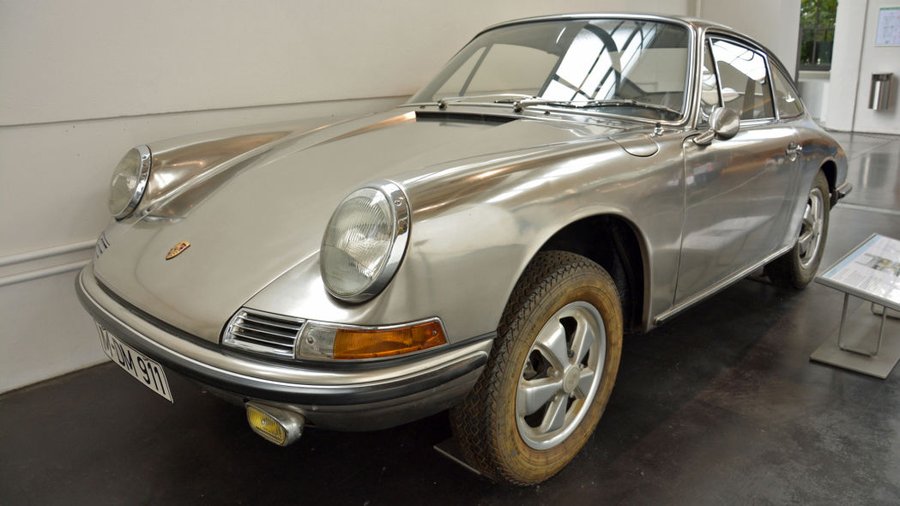The enduring mystery of the stainless steel Porsche 911

As the value of early Porsche 911s continues to skyrocket, collectors place an increasing amount of importance on provenance. Documented, matching-numbers examples are worth more than those with a murky past, and historians go to significant lengths to trace the history of each car that comes up for sale. And yet, one of the most unusual 911s, an experimental 1967 911S with a stainless-steel body, remains mostly unknown – as if it had never existed.
Though fully street-legal, it has been stashed in the Deutsches Museum's massive car collection in Munich, Germany, since 1974. Shedding light onto its past should be relatively simple, right? Have a pleasant chat with someone in Porsche's archives department, follow a paper trail, learn a few German words along the way, and uncover the car's secrets.
It wasn't. Months of research didn't lead us to the bottom of the story, but they allowed us to separate key facts from fiction.
The only piece of information Porsche has in its archives about the stainless-steel-bodied 911S is a scanned page out of the 1986 book Porsche Specials written by Lothar Boschen and Jurgen Bath. The blurb notes the 911S made its debut to the popping of flashbulbs at the 1967 Frankfurt Auto Show before embarking on a seven-year, 93,000-mile road test in the hands of Heinz Todtmann, the man who ran the Informationsstelle Edelstahl Rostfrei (Stainless Steel Information Center) in Düsseldorf, Germany. Porsche notably has no record of who commissioned or built the car.
Strike one.
Some believe Blanco, a German firm specializing in making kitchen faucets and sinks, built the body, but historians have challenged that claim. We spoke to a company representative who admitted he had never taken the time to look into its alleged role in creating this enigmatic coupe, and kindly told us he had no interest in doing so.
Strike two. What's the German word for "dead end" again?
Our most promising lead came from Dr. Lukas Breitwieser, the Deutsches Museum's curator. After digging through the museum's archives, he told us the car was first registered to the aforementioned Informationsstelle Edelstahl Rostfrei. While the organization still exists today, it's unable to explain how its name ended up on the title of a custom-built 911S. However, the fact that it appears on the original document strongly suggests someone working there commissioned the car. The title also lists the manufacturer as Porsche, meaning it was likely (but not certainly) built by the firm.
Here's what we do know: the body is made from cold-rolled steel shaped by both machines and humans. It's unpainted, much like the later DeLorean DMC-12, but it otherwise looks exactly like a run-of-the-mill 911S. In early 1972, Todtmann told ADAC's Motorwelt, a magazine published by Germany's rough equivalent to the American Automobile Association (AAA), he had put 60,000 miles on the car and it hadn't developed a speck of rust. It turned heads everywhere he went and he once got pulled over by a police officer who simply wanted to take a closer look at it.
Todtmann was wholly satisfied with the 911S, and it had exceeded everyone's expectations. Motorwelt wrote about a rust-free, 60,000-mile car with near-superstitious awe, which reveals how quickly cars made during that era ended up trapped in the mandibles of corrosion. But while the results were encouraging, making a mass-produced car out of stainless steel remained financially unviable because the manufacturing process was astonishingly expensive. Todtmann hinted that the special 911S cost roughly twice as much as a normal one. What's clear is that it was never a candidate for mass-production. It was, at best, a running and driving laboratory.
Body aside, the 911S is almost entirely stock. It's powered by an air-cooled, 2.0-liter flat-six engine that exhales through an aftermarket stainless-steel exhaust system to deliver 160 horsepower. It tips the scale at 2,270 pounds, a figure which makes it approximately 110 pounds lighter than a regular-production example.
One fascinating tidbit of information in Boschen and Barth's book is that the car displayed in the Deutsches Museum is one of three made with a stainless-steel body. This contradicts a story published in a 1967 issue of Motorwelt, which refers to the 911S as a one-of-a-kind model. Both might be correct; it's not too far-fetched to imagine the two additional examples were built in 1968, or later.
Their fate – assuming they existed – remains unknown. Keep your eye out for a shiny, early 911 hiding behind hay bales the next time you're jaunting across rural Germany.


Verwandte Nachrichten
